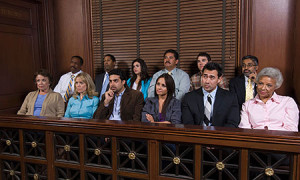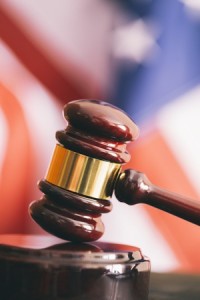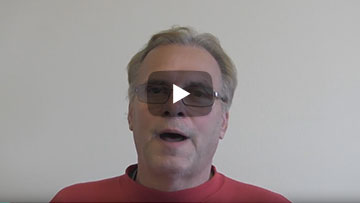Most truck accident cases in the United States today are settled without a trial. Trial is the culmination of months or years of work by your Kansas City truck accident lawyer in investigating the facts of your truck crash, researching the law, collecting evidence, conducting discovery, planning case strategy and doing the many other things it takes to prepare for your truck accident trial. It also likely means that for one or more reasons, attempts to settle the case have not worked.
Your right to have your case tried before a jury of your peers traces back to the earliest days of our country and continues today. Some people think that it is the best and fairest system yet devised to resolve disputes. If for some reasons both sides don’t want to have a jury trial they can usually request that the case be decided by a judge only (called a bench trial). Generally, it takes both parties to agree to a bench trial. If either side asks f a jury trial, you will usually get one.
In a jury trial the jury decides some issues and the judge usually decides certain other ones. For example, the fault of each party and the amount of damages you are awarded are usually decided by the jury. The judge usually decides purely legal issues like whether certain things can be used evidence in the case.
Jury Selection (also known as Voir Dire)
Aside from conferences with involving the judge and lawyers and possibly some preliminary court rulings, choosing who will serve on the jury is usually the first major step in a jury trial
Juries in civil cases in the United States today usually are six or twelve jurors and one or more alternate jurors. The number of jurors on your case depends in part on the rules of the court system in which your truck accident case is being handled. For example, in the federal court system juries on civil cases are often six members, plus alternates. In many state court systems twelve jurors are the norm.

While courts have varying systems, after jurors arrive in the court room, the judge often shares with them some basic information about what is going to happen. The judge may then ask them some preliminary questions and allow the lawyers to question the jurors. The specifics of this process vary from court to court.
The goal of jury selection is to get a jury which can render a fair and impartial verdict. During jury selection, the lawyers on each side are trying to learn enough about the jurors by reading juror questionnaires, asking them questions and listening to responses to decide which jurors are least favorable for their case and avoid having them on the jury.
Potential jurors are usually taken out of the case through a “challenge for cause” or “preemptory challenge”. Generally, any number of jurors who meet the criteria for a challenge for cause may be removed. Each side is also given a limited number of preemptory challenges. No reason is required to exercise a preemptory challenge. Lawyers will often first try to remove a juror for cause and, if the cause challenge doesn’t work, and they really don’t want that person on the jury, then use one of their few preemptory challenges to remove them.
After all the challenges have been resolved and potential jurors excused, the court will usually seat and swear in the jury. The court may then give the jury some preliminary directions called “instructions”. The trial can then begin.
Opening Statements
Opening statements are the next major step. Opening statements are each side’s opportunity to tell the jury about the case and discuss what evidence they intend to use to prove their case. The plaintiff gets to go first, followed by the defendant. In many courts it is improper to argue about the evidence in opening statements, or to discuss information which the lawyers do not believe, in good faith, that evidence supporting these statements will be admitted during trial. Some courts limit the amount of time allowed for opening statements.
Evidence
Information usually becomes evidence (lawyers and judges call it “admitted into evidence”) at trial in two forms. One is through the live or recorded witness testimony. The other is through documents or other things, called “exhibits”. Witnesses we might want to use in the trial of your truck accident case include you, your spouse, other people who witnessed your wreck, your treating doctor, expert witnesses, the investigating police officer, the other driver and others. We may also introduce the testimony of the truck driver and trucking company given at their depositions. Some exhibits we might offer as evidence includes video of the crash from the truck’s dashcam, pictures and diagrams of the crash scene, photos of the damaged vehicles and your injuries, medical records and bills.
Detailed, technical rules control what and how evidence is admitted during a trial. In the federal court system, many of these rules are contained in the Federal Rules of Evidence. States usually have their own evidence rules which may or may be similar to the Federal Rules of Evidence.
Part of what lawyers do when they prepare a case for trial is to decide what evidence they want to submit and get the evidence so that it can be admitted under the rules of evidence. This may mean asking questions during depositions in the proper form, so they are not objectionable at trial, obtaining proper “authentication” of business records which may be offered at trial and having the evidence required to establish the proper foundation for other evidence which may be offered.
Lawyers trying to prevent the admission of evidence they think will help the other side or hurt their case have a number of tools at their disposal. At the pretrial conference, or before trial, they may request that the judge order that certain evidence may not be admitted or offered at trial. Usually, lawyers may also object to evidence when it is offered at trial. Some common objections that you may have seen on lawyer movies and television shows include irrelevant, immaterial, calls for a conclusion, leading question and calls for speculation. There are numerous other objections.
At trial, after an objection is made, the judge decides or “rules” on it. If the objection is overruled, the evidence can be admitted. If the judge sustains the objection the evidence may not be used.
Plaintiff’s Case in Chief
In the American court system the person bringing a claim is usually called the plaintiff. They typically have the “burden of proof” to prove their claim. In part because of this, the plaintiff presents their case “case in chief” first. Broadly speaking, the issues in a truck accident jury trial often break down into what lawyers call “liability” and “damages”. Liability refers to who is, and in what proportions, are responsible for causing the truck crash in which you were injured. Damages is about your losses from the crash. For example, medical expenses, lost income, disability, reduced earning capacity, pain and suffering.
How much proof is required in a truck accident case depends on the claims being made. Most often your claims must be proven by the “preponderance of the evidence”. Certain kinds of claims in a truck wreck case may require a higher level of proof.
Part of the trial lawyer’s job is to evaluate the evidence, determine what evidence is needed or would be most useful to prove your claims. They then must decide the witnesses, documents or other exhibits needed to use to get this admitted into evidence and decide the best way and order to present this evidence.
Opinions and strategies vary about the best way to do this. One way is to call the plaintiff first, then present the medical testimony and other evidence about your damages, followed by the evidence which proves the driver’s liability for your injuries. Another way is to first establish the truck driver and trucking company’s liability and then present the medical and damage evidence.
Either way, the trial lawyer and/or the trial team has to carefully define the order in which evidence will be presented and sequence the arrival of live witnesses so they arrive at proper times for their testimony. They also need make sure that exhibits are ready in admissible form and presented at the right time with the necessary testimony to establish the basis for their admissibility. Evidence or trial aids being presented through the use of technology like PowerPoints, testimony presented on video and other exhibits need to be working properly and presented at the right time. All this while dealing with defense objections, presenting a persuasive case and responding to the array of other unexpected issues and problems which can arise. It can be a tall order.
After the plaintiff has submitted all the evidence they plan to offer, they may say “Your Honor the plaintiff rests” or similar words. It is then the defense’s opportunity to present their evidence.
Defendant’s Case in Chief

Lawyers often use the word liability to describe responsibility for causing the plaintiff’s injuries. The truck driver’s defense lawyer may try to introduce evidence that the semi wreck happened differently than your evidence shows. One way to do this is by having an eyewitnesses whose testimony contradicts the testimony and other evidence which was admitted by the plaintiff about how the wreck occurred. Another common method is to try to prove that the collision was partly or completely your fault or the fault of someone other than the trucker and trucking company.
Defense attorneys will also often try to attack or minimize the plaintiff’s damage evidence. Common ways to do this are to try to present evidence that the plaintiffs problems are not as bad as the plaintiff claims, were not caused by the collision, were pre-existing conditions from other injuries or caused by degenerative changes which occur as we age.
Offering evidence from a so-called “independent medical exam” or IME is another common defense technique. Here, the trucking company’s lawyers usually select and pay a doctor to examine you for purposes of the case and give opinions and testimony about your injuries and whether they were caused by the truck crash, medical treatment and other things. The doctor may write a report and may also testify about these things.
These are just a few of the many techniques that defense lawyers in your truck accident case may have available. Available time and space prevent us from describing all of them. But it’s very likely that a skilled defense lawyer knows how to use them for the truck driver and trucking company’s benefit at trial.
Rebuttal
After each side has presented their case in chief, usually each side will have an opportunity to present rebuttal evidence.
Plaintiff’s Closing Argument
After both sides have presented all their evidence and rebuttal it is time for closing arguments. Typically, the plaintiff goes first. The plaintiff’s lawyer has several goals during closing argument. The trial may have taken several days or weeks. All of the evidence that the jury heard, particularly early in the case, may not be fresh in the juror’s memories. Further, due to witness scheduling issues or other considerations evidence may have been presented out of what might seem to be a logical sequence.
Your lawyer, in closing argument, should review and draw together the evidence which support your claims. Your truck accident attorney should go over the evidence which proves the truck driver’s fault and the lack of fault by you and possibly others. If the defense submitted evidence to show that liability is other than you claim, your lawyer may want to highlight evidence which shows why the defense claims should not be believed.
Your attorney should also review the damage evidence with the jury and address defenses which have been made to the damage claims. They may provide a detailed explanation to the jury of how the amount of damages being requested was determined. Specific items of damages like past and future medical expenses, lost income, reduced earning capacity, pain and suffering, and other things usually can be discussed. They should tell jury know how much the you are asking for and why they should give you that amount.
Defendant’s Closing Argument
Once your lawyer is finished, the defense may present their closing argument. In some cases, the defense will try to highlight the evidence which negates your claims about the truck driver and trucking company’s liability. They may discuss evidence which has been admitted showing that the crash did not occur the way you claim or show that you or some one else is partially or completely at fault for the wreck. If the defendant’s liability is clear-cut enough their lawyer may actually admit that they are responsible and liable.
The defense lawyer will almost certainly discuss damages. They will try to explain why the jury should award less damages than your lawyer is asking for or possibly even no damages. Using evidence which was admitted during the trial, they may try to show that the medical expenses were not reasonable, that future medical expenses claimed are not necessary, that the past or projected future lost income calculations are too high, that the injuries claimed are not caused by the crash and the fault of the trucking company and it’s driver and possibly make other arguments.
After the defense has completed their closing argument, your attorney may have the opportunity to make a rebuttal argument.
Jury Instructions
Once the attorneys have completed their closing arguments, it is time for the judge to provide “instructions” to the jury. Jury instructions are relatively short statements of the law that the jurors are to use in deciding the case. Many states have “model”, “pattern” or “approved” sets of jury instructions from which the lawyers can select appropriate jury instructions. Before the judge to give the instructions to the jury the lawyers will often have prepared sets of jury instructions which they want the judge to use and provided them to the court.
Often the lawyers are able to agree on some of the instructions to be used. In some other situations, they cannot agree, and so the judge will review the different alternatives submitted by the attorneys and decide which ones to use.
Once a final set of instructions has been determined the judge will “instruct” or “charge” the jury. This means that the judge will, in open court, read the instructions to the jury so they know what legal rules, they are required to use to decide the case. The jurors may be allowed to take copies of the instructions with them into the jury room.
Jury Deliberations
After the judge has instructed the jury, they will enter or “retire” to the jury room to decide the case. The process they will go through is called deliberation. Typically, after entering the jury room, the jurors will select a “foreperson”. Often, the foreperson provides some leadership in the deliberation process, and after the verdict is rendered, will deliver it in the courtroom.
Verdict and Judgment

The judge will then ask the jury if they have reached a verdict. The juror selected as the foreperson will advise the court that they have reached a verdict and often present a written verdict form to the bailiff or courtroom deputy to be given to the judge. Typically, the judge will read the verdict form and announce the jury’s verdict.
If either of the parties are not satisfied with the result, they may be able to file a motion asking that the verdict be set aside, ask for other relief or appeal the judgment. There generally time limitations for either of these.




